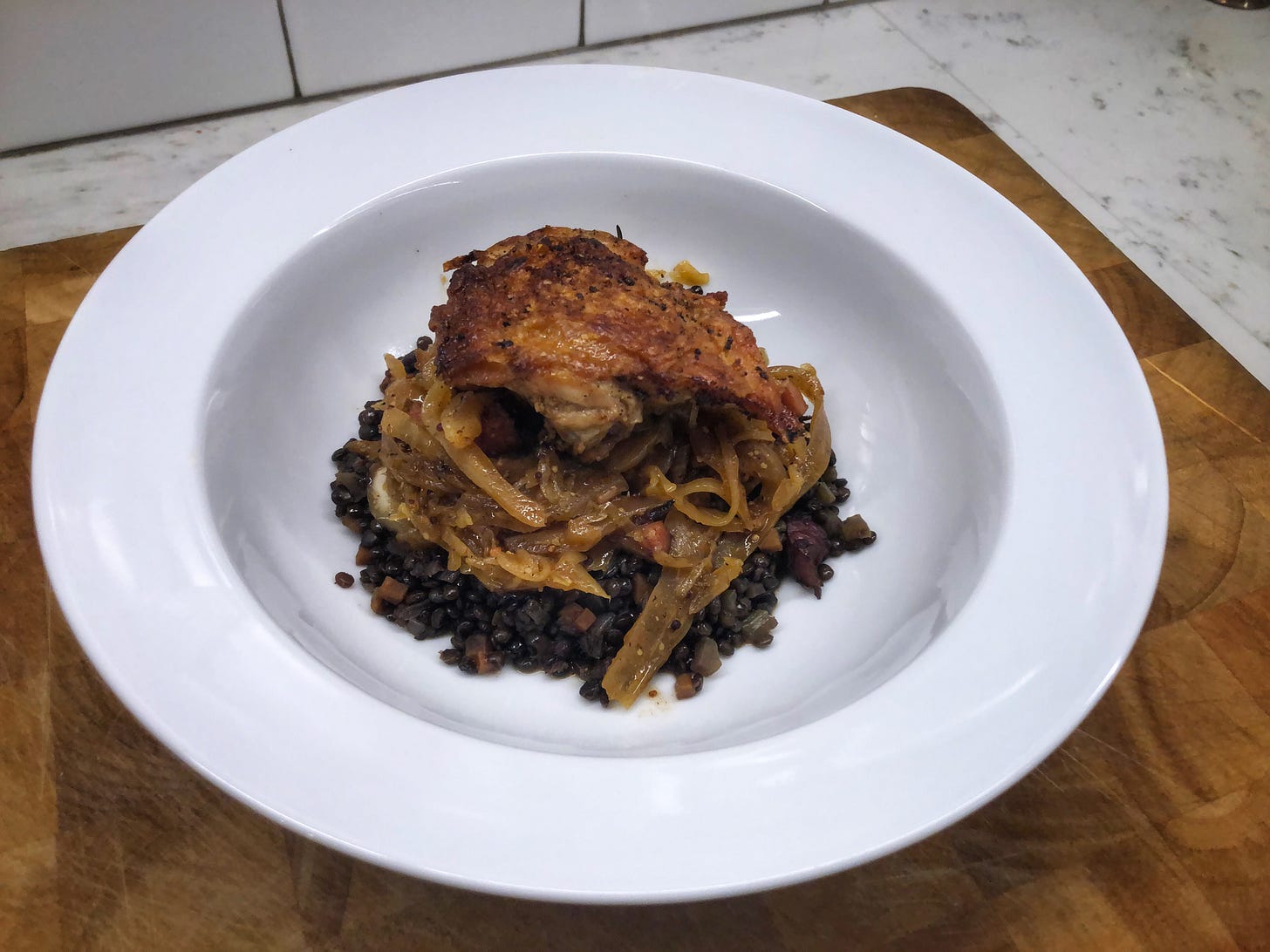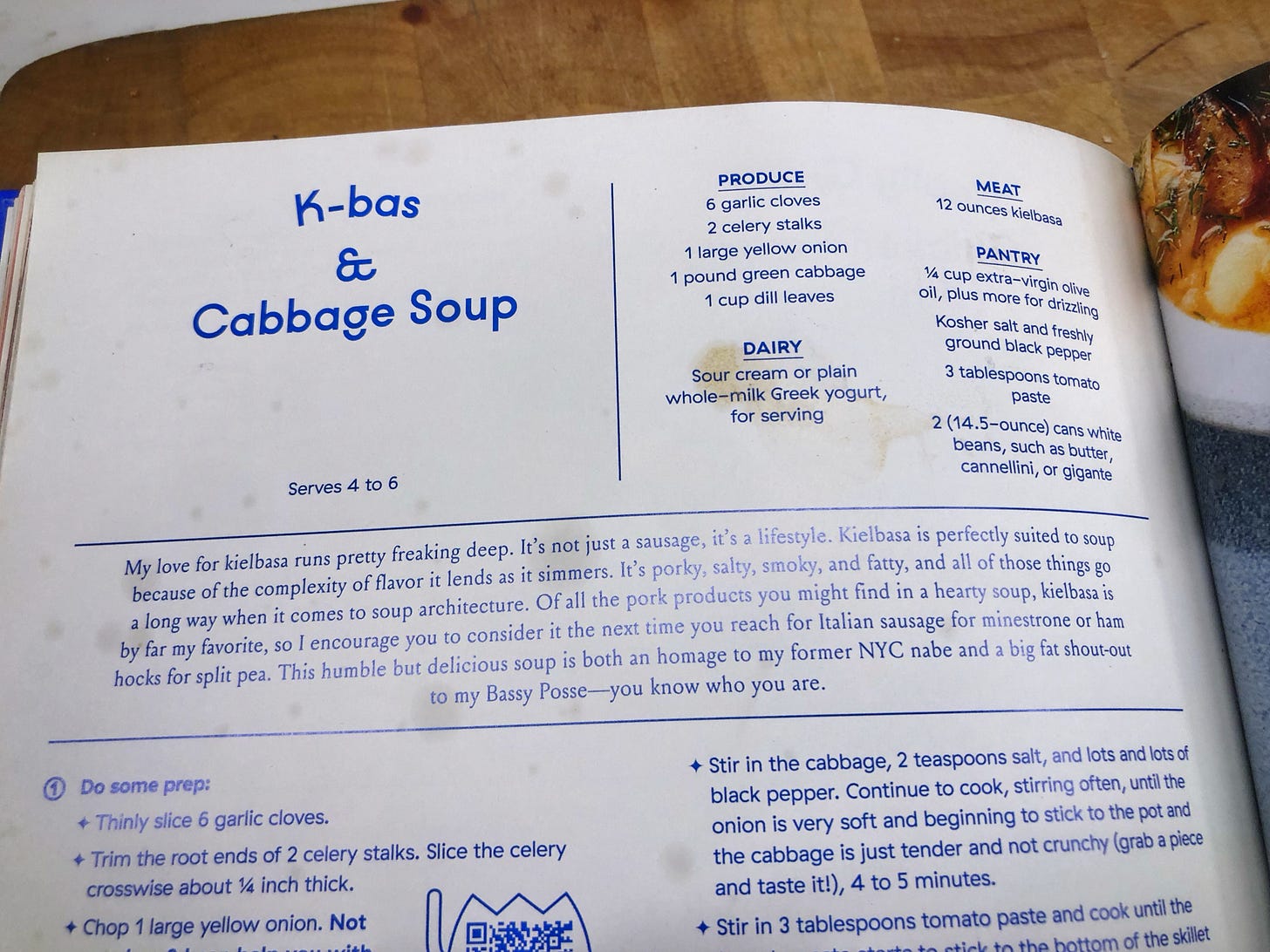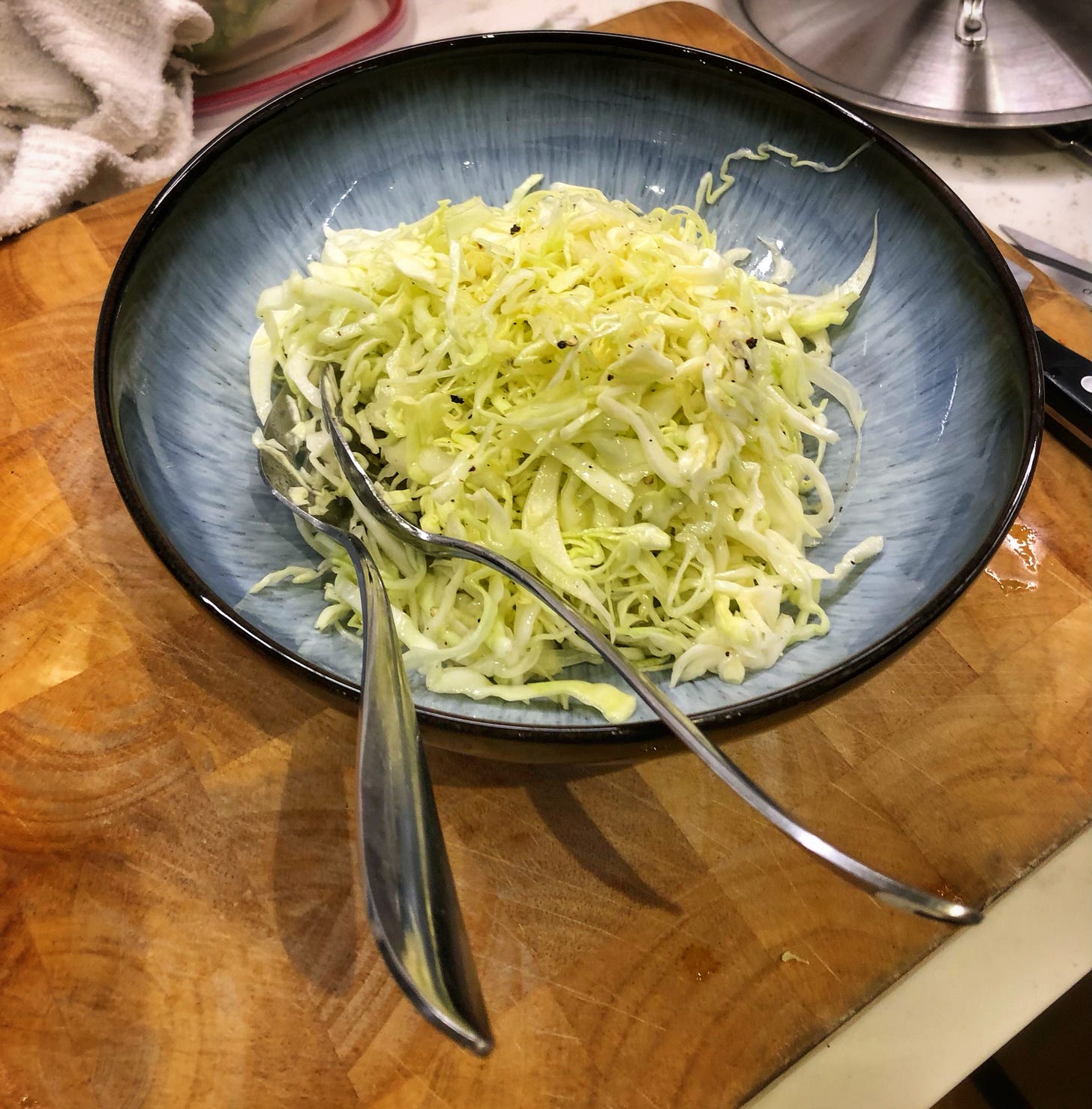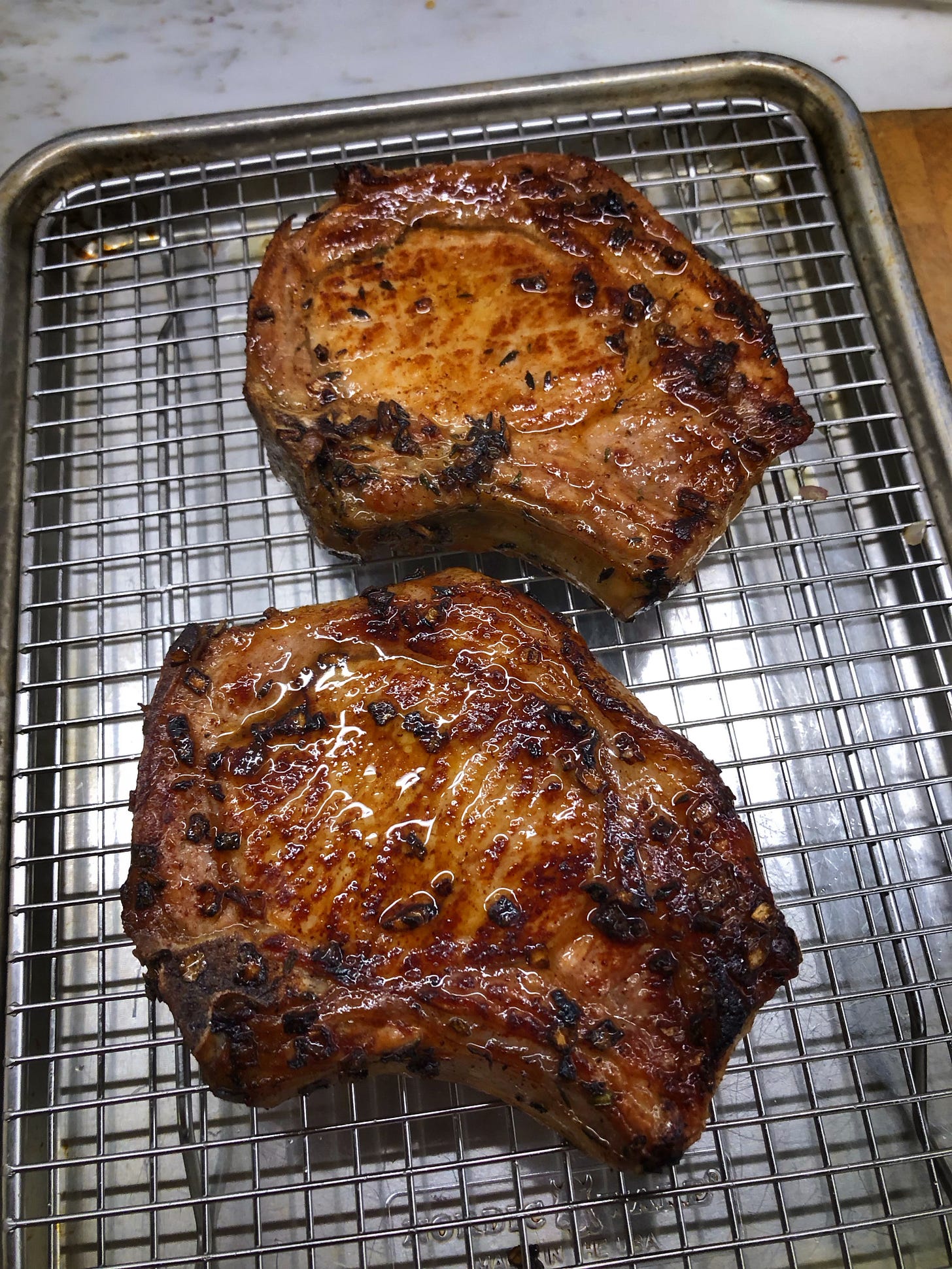32. Using all of my head
One purchase, eight dishes, almost zero waste
I’ve noted before1 that compared to Canadian cabbages, American cabbages are freakishly small. I’ve had friends who live in the US text me photos of cabbages at their local supermarkets and they confirmed what I had begun to suspect because of recipes like this one for Crispy Braised Chicken Thighs With Cabbage and Bacon. It calls for “1 pound finely shredded cabbage (about 1 medium head; 450g).” The smallest cabbage I could get at Fiesta Farms weighed in at 7.5 lbs, so after this dish, I was going to have a lot of extra cabbage on hand.
The recipe, by the way, is terrific. You first cook the chicken thighs undisturbed and skin-side down in a dutch oven until the skin is deeply golden and crispy but the rest of the thigh is mostly uncooked. Setting the thighs aside, the bacon, cabbage, and other ingredients are sautéed until soft, and then stock and cider vinegar get added. When it is at a simmer, the thighs are nestled skin-side up into the stew, leaving the skin above the liquid to stay crispy while everything else simmers to a gorgeous softness. I served it on top of a bed of Beluga lentil ragout that some of you may remember from a very early post.
Faced with the other 6.5 lbs of cabbage, I resolved to use it all up before it was no longer useable. Fortunately, it’s hearty enough to stick around for a while without getting gnarly. If I resolved to eat 6.5 lbs of leaf lettuce or arugula before it went bad, I’d have to pack it all into about three meals.
A few days later, I used about four cups of shredded cabbage in one of our favourite sides, the simply named Spiced Indian Cabbage, which I started making early in the pandemic. If you’ve been reading The Plate Cleaner for a while, you’ve probably read references to it before. It’s one of my favourite uses for cabbage and makes a great side for Instant Pot Chicken Tikka Masala.2
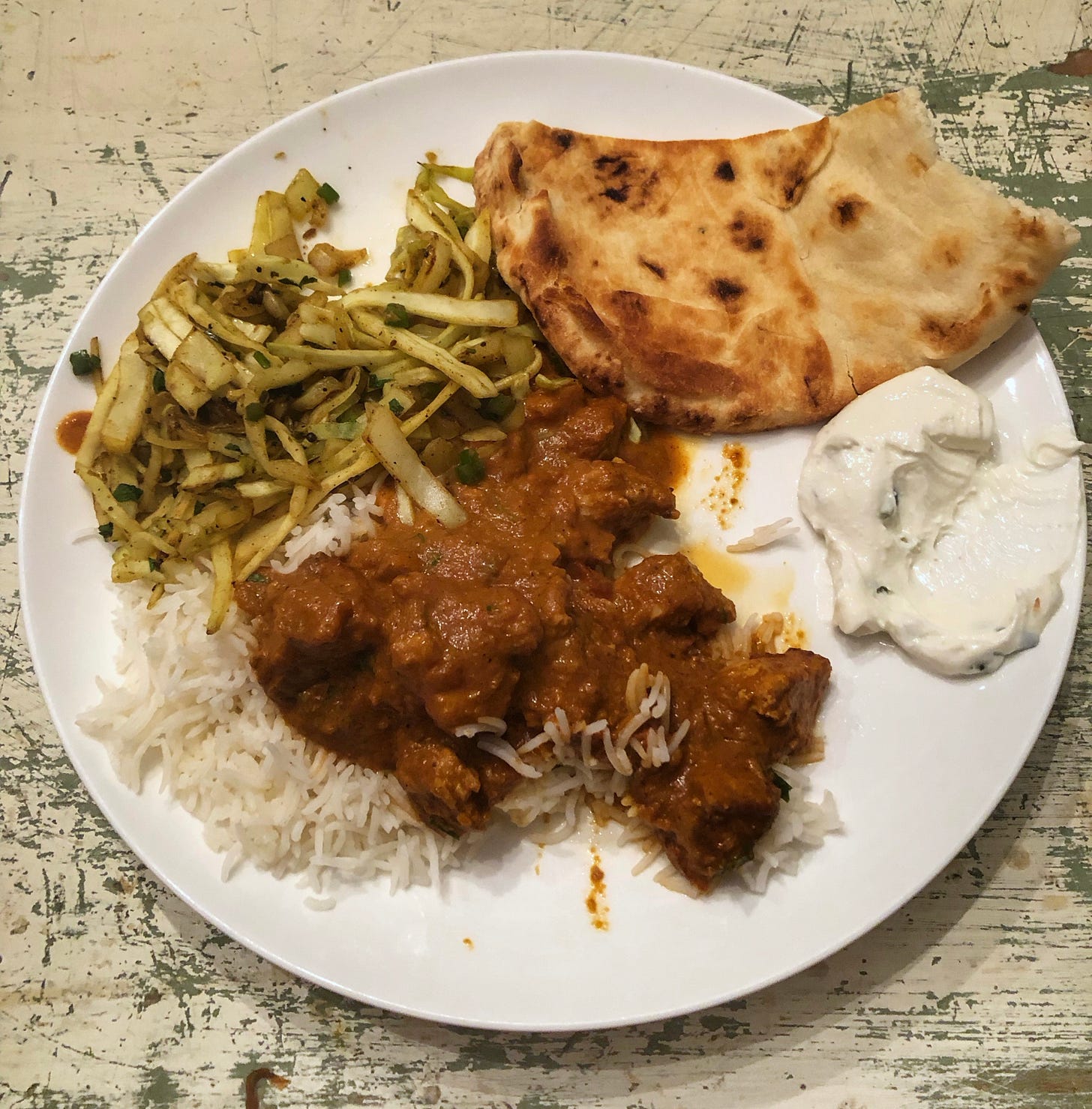
A few days after that, another pound went into a batch of Molly Baz’s K-bas (kielbasa) and Cabbage Soup from her terrific Cook This Book. I had some chicken stock left over from the chicken thighs and cabbage, as well as some pre-cooked chick peas in the freezer, so this was not only a good and hearty meal, but also an opportunity to gain some storage space back. The original recipe calls for water instead of stock, presumably to make it even easier, but where’s the harm in using stock instead? It also comes together very quickly, mashing some of the chick peas to give the broth more body. But again there’s no harm in leaving it to simmer for a while longer to make it even better.
By the weekend, the cabbage, which had now been at our house for a little over a week, was over half-eaten and still in very good shape. Beth roasted about half of what remained in a hot oven with some onions until they were starting to brown in places. These sweet, roasty flavours went into four lunches during the week. (I was elsewhere when this happened, so I don’t have a photo.)
And finally, a full two weeks after the cabbage came to us, I used the rest in another round of Spiced Indian Cabbage and Chicken Tikka Masala, using the extra sauce from the first round, which I had frozen, to braise the chicken. Once it was cooked, I removed the chicken chunks to a sheet pan and put them under the broiler to brown and char a little. Once I was happy with their colour, they went back into the sauce.
The last use was a duplicate, but there are definitely other ways to use up a cabbage. If I had had more forethought, I would have peeled away some of the big outer leaves to make cabbage rolls.3 Or shredded some of it straight away to ferment a small batch of sauerkraut.4 Or made another standby for us, Andalusian Cabbage Stew. Or the easiest great salad around, Insalate Cappuccio, which I entirely stole from Famiglia Baldassare. Just slice cabbage as thinly as you can (a mandolin and a cut-resistant glove are great for this) and dress it with lemon juice, olive oil, salt, and pepper.
What I’m consuming…
I should change the name of this feature to “I’m late to the game on this,” because that seems to be how I preface about half of them. In this case, it’s The Woks of Life, a project by the Leungs, a family of four who at first wanted to document their family’s history through food. Since 2013 it has grown to become an amazing resource on Chinese cooking, both American takeout style and, for lack of a better term, more authentic Chinese dishes. There are recipes, but also guides to techniques, equipment, and ingredients. Along with Made with Lau, which I featured previously, and Chinese Cooking Demystified (ditto), there are some great resources for anyone interested in learning more about Chinese cuisine.
This episode of The Sporkful, about trying to uncover the provenance of a very unusual bottle of whisky, reminded me a lot of Mystery Show, Starlee Kine’s fantastic show that got cancelled far too early. Case #3: The Belt Buckle is a good gateway episode for that podcast.
What’s on the menu….
Molasses-brined pork chops—Rachel, the creative director at the agency I’m currently freelancing for, and I were talking about pork chops. (Because of course!) She was telling me about the pork chop of her dreams, served at the now-closed Brooklyn Star.5 I wasn’t going to make the onion rings that went on top of it, and the grill has been put away for the winter, but I found a recipe for a similar brine and then reverse seared it.
I forgot to get the chops into the brine with enough time to let them steep for six hours, so mine only got around three. Still, they were juicy and flavourful and I will definitely try again with a longer brining time. The collards braised with a smoked pig tail were a nice accompaniment.
Fresh Garam Masala — I was out of Garam Masala and needed some for my second batch of Spiced Indian Cabbage. Fortunately, Uvashi Pitre’s recipe from The Indian Instant Pot Cookbook6 takes about 5 minutes to assemble and grind. Straight out of my spice grinder, the smell was heavenly. As it ages, the scents of the different ingredients tend to flatten and blend. But just moments after blending, each component was distinct and harmonizing beautifully with the others.
As always, I’d love to know what you’re consuming and what’s on your menu. (And your go-to cabbage recipes!) If you’re a subscriber, simply reply to this email. Or you can leave a comment by clicking the button below.
Some would say “complained”.
This recipe makes two batches of sauce while cooking one batch of chicken, so you can freeze the extra sauce for use when you want something tasty and complex like Chicken Tikka Masala, but you don’t have to time to make it from scratch.
I’m still looking for a go-to recipe for cabbage rolls. If you have any tips for a good one, please let me know.
If you’re going to ferment a vegetable, start the fermentation when it’s as fresh as possible. Fermentation is basically controlled rot and if your vegetable isn’t fresh, you have less control over that rot.
It’s noteworthy enough to have its own hashtag on Instagram: #bkstarchop.
Most of Pitre’s recipes from that book seem to also be on her website. Possibly because of the raw deal she got from her publisher, she seems not overly fussed if she cannibalizes the book’s sales.



